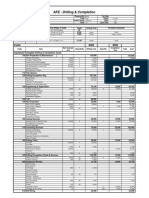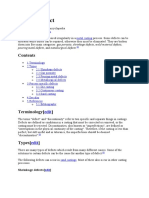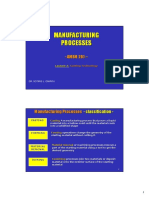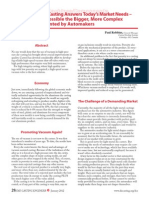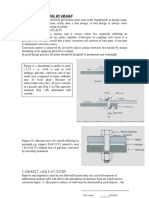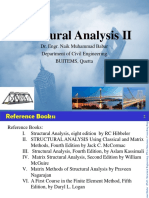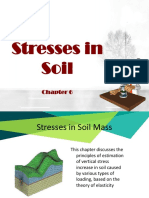10 Rules For Casting
10 Rules For Casting
Uploaded by
Bijendra PrajapatiCopyright:
Available Formats
10 Rules For Casting
10 Rules For Casting
Uploaded by
Bijendra PrajapatiOriginal Description:
Original Title
Copyright
Available Formats
Share this document
Did you find this document useful?
Is this content inappropriate?
Copyright:
Available Formats
10 Rules For Casting
10 Rules For Casting
Uploaded by
Bijendra PrajapatiCopyright:
Available Formats
Rule 1: Good-Quality Melt
Immediately prior to casting, the melt shall be prepared and treated, if necessary, using the best
current practice.
Rule 2: Liquid Front Damage
This is the requirement that the liquid metal front (the meniscus) should not go too fast.
Maximum meniscus velocity is in the range of 0.4 to 0.6 m/s (1.3 to 2.0 ft/s) for most liquid
metals. This maximum velocity may be raised in constrained running systems or thin-section
castings. This requirement also implies that the liquid metal must not be allowed to fall more
than the critical height (which corresponds to the height of a sessile drop of the liquid metal).
Rule 3: Liquid Front Stop
This is the requirement that the liquid metal front should not go too slowly and, more exactly,
should not stop at any point on the front. The advancing liquid metal meniscus must be kept
alive (i.e., moving) and therefore free from thick oxide film that may be incorporated into the
casting. This is achieved by designing the liquid front to progress only uphill in a continuous
uninterrupted upward advance (in the case of gravity-poured casting processes, from the base of
the sprue onward).
Rule 4: Bubble Damage
No bubbles of air entrained by the filling system should pass through the liquid metal in the mold
cavity. This may be achieved by:
_ Use of an offset step pouring basin design of sufficient size to facilitate detrainment of
entrained air and oxides; preferred use of a stopper to aid the filling of the basin; the use of sprue
and runner designed to fill in one pass; avoidance of the use of wells or other volume-increasing
features of filling systems; possible use of ceramic foam filter close to sprue/runner junction;
possible use of bubble traps
_ No interruptions to pouring
Rule 5: Core Blows
_ No bubbles from the outgassing of cores should pass through the liquid metal in the mold
cavity. Cores must be of sufficiently low gas content and/or adequately vented to prevent
bubbles from core blows.
_ No use of clay-based core or mold repair paste (unless demonstrated to be free from the risk of
creating bubbles)
Rule 6: Shrinkage Damage
_ No feeding uphill because of unreliable pressure gradient and complications introduced by
convection
_ Demonstrate good feeding design following all seven feeding rules, by an approved computer
solidification model and test castings
_ Control of the level of flash at mold and core joints, the mold coat thickness, and the
temperatures of metal and mold
Rule 7: Convection Damage
Assess the freezing time in relation to the time for convection to cause damage. Thin and thick-
section castings automatically avoid convection problems. For intermediate sections, either
reduce the problem by avoiding convective loops in the geometry of the casting and rigging, or
eliminate convection by rollover after filling.
Rule 8: Segregation
Predict segregation to be within the specification limits or agree upon out-of-specification
compositional regions with the customer. Avoid channel segregation formation if possible.
Rule 9: Residual Stress
No quenching of certain light-alloy castings into water following solution treatment. (Boiling
water is also not permitted for these castings, but polymer quenching or forced-air quench may
be acceptable if casting stress is shown to be negligible.)
Rule 10: Location Points
All castings are to be provided with agreed upon location points for dimensional reference and
for pickup for machining.
You might also like
- Nissan KA24E Engine ManualDocument256 pagesNissan KA24E Engine ManualPhasin Chitutsaha75% (4)
- Example 1 H AFEDocument2 pagesExample 1 H AFEplyana75% (4)
- Runners, Gates and Feed System DataDocument23 pagesRunners, Gates and Feed System DataMariver LlorenteNo ratings yet
- Sand CastingDocument11 pagesSand CastingdesurkarbNo ratings yet
- NADCA-High Temp DieDocument12 pagesNADCA-High Temp DiejalilemadiNo ratings yet
- GAS PROBLEM in Steel Sand CastingsDocument7 pagesGAS PROBLEM in Steel Sand CastingsVasu RajaNo ratings yet
- Advance Earthquakeresistant TechniqueDocument16 pagesAdvance Earthquakeresistant TechniqueKANJAKSHYA BISWAL67% (3)
- Casting Defect: Pouring Metal Defects, and Metallurgical DefectsDocument7 pagesCasting Defect: Pouring Metal Defects, and Metallurgical DefectsSama UmateNo ratings yet
- Methoding Design in Sand Casting HeuristDocument8 pagesMethoding Design in Sand Casting Heuristaciwe aciliwielNo ratings yet
- 3D Junctions in CastingsDocument8 pages3D Junctions in CastingsKamalesh SinghNo ratings yet
- Design of Gravity Die CastingsDocument25 pagesDesign of Gravity Die CastingsM PraveenNo ratings yet
- Lost Foam CastingDocument31 pagesLost Foam Castingokicirdar100% (1)
- We Are Intechopen, The First Native Scientific Publisher of Open Access BooksDocument15 pagesWe Are Intechopen, The First Native Scientific Publisher of Open Access BooksKarthick PNo ratings yet
- Procast - ESI - Casting SimulationsDocument14 pagesProcast - ESI - Casting Simulationsvmgobinath100% (2)
- Design and Analysis of Riser For Sand CastingDocument16 pagesDesign and Analysis of Riser For Sand Castingrpadhra8803No ratings yet
- Metal Casting ProcessesDocument98 pagesMetal Casting ProcessestmcoachingcentreNo ratings yet
- On Gating SystemDocument19 pagesOn Gating SystemMurali Krishnan SelvarajaNo ratings yet
- Study of Metal Flow in CastingDocument8 pagesStudy of Metal Flow in CastingKhushi ShahNo ratings yet
- Solidification of Castings-FDocument7 pagesSolidification of Castings-FAshok PradhanNo ratings yet
- MP - Module 1 - Casting ProcessesDocument108 pagesMP - Module 1 - Casting ProcessesrohanNo ratings yet
- Metal Casting Design: Mold and Gating System Design, Directional Solidification, and TroubleshootingDocument7 pagesMetal Casting Design: Mold and Gating System Design, Directional Solidification, and TroubleshootingzidaaanNo ratings yet
- Design Optimization of Gating and FeedinDocument9 pagesDesign Optimization of Gating and FeedinJoao LuisNo ratings yet
- Solid CastDocument55 pagesSolid Castcesar_abddNo ratings yet
- CASTING DEFECTS AND REMEDIAL MEASURES (Final)Document51 pagesCASTING DEFECTS AND REMEDIAL MEASURES (Final)Mahadev OraonNo ratings yet
- Casting IntroDocument94 pagesCasting IntroJith ViswaNo ratings yet
- Foundry I - Complete Lab Manual at WWW.07MET - TKDocument18 pagesFoundry I - Complete Lab Manual at WWW.07MET - TKAnil Kumar100% (1)
- Chapter 10 Casting IDocument38 pagesChapter 10 Casting IMinhaj UllahNo ratings yet
- Cast3 PDFDocument67 pagesCast3 PDFyash guptaNo ratings yet
- Microsoft PowerPoint - LECTURE3Document36 pagesMicrosoft PowerPoint - LECTURE3Bassel AlshamiNo ratings yet
- Special CastingDocument24 pagesSpecial CastingManohara ErlaNo ratings yet
- Mesh Cast 20091Document456 pagesMesh Cast 20091Kmilo Giraldo100% (1)
- Cores and CoremakingDocument12 pagesCores and CoremakingupenderNo ratings yet
- Manufacturing and Casting of An Engine Block From Aluminium AlloysDocument28 pagesManufacturing and Casting of An Engine Block From Aluminium AlloysLumamba Chiyabi100% (2)
- 15mec - 213 Manufacturing Technology-I: Subject: 15mec 213-Manufacturingtechnology-I Class: 4 Sem B.Tech-Mech A'Document40 pages15mec - 213 Manufacturing Technology-I: Subject: 15mec 213-Manufacturingtechnology-I Class: 4 Sem B.Tech-Mech A'subash naraharasettiNo ratings yet
- VacuumDocument6 pagesVacuum03sri03No ratings yet
- CH 3 PDFDocument20 pagesCH 3 PDFHassaan SajidNo ratings yet
- Unit-1 Metal Casting ProcessDocument261 pagesUnit-1 Metal Casting ProcessDharun PrakashNo ratings yet
- 2 - 2 Fundamentals of CastingDocument172 pages2 - 2 Fundamentals of CastingColorgold BirlieNo ratings yet
- Sand Casting OverviewDocument166 pagesSand Casting Overviewsamurai7_77100% (1)
- Introduction in Alloys and Influence of Elements: Alloys and Melting 01 - Alloys - and - Melting - EN - Docx 1/13Document13 pagesIntroduction in Alloys and Influence of Elements: Alloys and Melting 01 - Alloys - and - Melting - EN - Docx 1/13luisA1923No ratings yet
- U02P01 B.A.A Intro MetalCastingDocument35 pagesU02P01 B.A.A Intro MetalCastingmaria100% (1)
- Modal Analysis of Porosity Defects in High Pressure Die Casting With A Neural NetworkDocument5 pagesModal Analysis of Porosity Defects in High Pressure Die Casting With A Neural NetworkVirus046No ratings yet
- Casting and Casting Processes: Prof. (DR.) Dalgobind Mahto 3/10/2015Document28 pagesCasting and Casting Processes: Prof. (DR.) Dalgobind Mahto 3/10/2015keethanNo ratings yet
- Gating System and Feeder Design of Aluminium Alloy (AA6063) Casting For Rectangular ComponentDocument6 pagesGating System and Feeder Design of Aluminium Alloy (AA6063) Casting For Rectangular ComponentPankajNo ratings yet
- Production of Automotive Components: Jerome GDocument24 pagesProduction of Automotive Components: Jerome GMr. Jerome Nithin Gladson100% (1)
- Casting Basis-Rev 2Document27 pagesCasting Basis-Rev 2Vasudev DevNo ratings yet
- Metal CastingDocument8 pagesMetal CastingYash DesaaiNo ratings yet
- Classification of Casting TechniquesDocument16 pagesClassification of Casting TechniquesRehan SharmaNo ratings yet
- Gas Defects:: These Are Spherical, Flattened or Elongated CavitiesDocument3 pagesGas Defects:: These Are Spherical, Flattened or Elongated CavitiesmaniNo ratings yet
- Roll ForgingDocument6 pagesRoll ForgingSaptarshi SinhaNo ratings yet
- IE 337 W10 Lecture 7.casting 1Document48 pagesIE 337 W10 Lecture 7.casting 1linkinunNo ratings yet
- Casting Defects - Sand Mold, Metal Casting PDFDocument10 pagesCasting Defects - Sand Mold, Metal Casting PDFAbhinav Pratap MauryaNo ratings yet
- Casting DefectsDocument10 pagesCasting DefectscarrespmNo ratings yet
- Casting Lecture NoteDocument12 pagesCasting Lecture NoteHARIMETLYNo ratings yet
- Foundry Bhel1Document7 pagesFoundry Bhel1Charu MallNo ratings yet
- Casting Defects and RemediesDocument7 pagesCasting Defects and Remediesvignesh waran sNo ratings yet
- Gating System For Casting2 - WT7 PDFDocument87 pagesGating System For Casting2 - WT7 PDFAzaad Maverick100% (1)
- Casting ProcessesDocument18 pagesCasting ProcessesvelavansuNo ratings yet
- Hot Chamber Die Casting MachineDocument3 pagesHot Chamber Die Casting MachineAnand BossNo ratings yet
- Chapter 4 Gating SystemDocument54 pagesChapter 4 Gating Systemjoy fulNo ratings yet
- Publication 12 18403 228Document7 pagesPublication 12 18403 228Minh QuânNo ratings yet
- Pressure Relief Valves: Type DB500/700/1000Document11 pagesPressure Relief Valves: Type DB500/700/1000PRASHANT KANTENo ratings yet
- Compression Design Section2Document10 pagesCompression Design Section2Anonymous sfkedkymNo ratings yet
- Structural Analysis II: Dr. Engr. Naik Muhammad Babar Department of Civil Engineering BUITEMS, QuettaDocument99 pagesStructural Analysis II: Dr. Engr. Naik Muhammad Babar Department of Civil Engineering BUITEMS, QuettaMir Ali AbbasNo ratings yet
- Katalog Co-470 To Co-560Document1 pageKatalog Co-470 To Co-560Iqbal AbugindaNo ratings yet
- FDS Lab03Document7 pagesFDS Lab03Mack99tsNo ratings yet
- ADC Part 1Document1 pageADC Part 1Maung PDDNo ratings yet
- Tank Weighing ManualDocument42 pagesTank Weighing ManualManoj Kage100% (1)
- Practical 2Document4 pagesPractical 2June Lee Wong MYNo ratings yet
- Akaki W2 3 by 1 (1st Payment)Document9 pagesAkaki W2 3 by 1 (1st Payment)Hiwot MeleseNo ratings yet
- Constancy Testing Services: Research &Document6 pagesConstancy Testing Services: Research &SaJedur RahmanNo ratings yet
- A Case Study On Inelastic Seismic Analysis of Six Storey RC BuildingDocument6 pagesA Case Study On Inelastic Seismic Analysis of Six Storey RC BuildingFreedom of speech100% (1)
- WOR300Document56 pagesWOR300indyukNo ratings yet
- User Manual: Item: Accessories For Pressure GaugeDocument9 pagesUser Manual: Item: Accessories For Pressure GaugeVan Luong BuiNo ratings yet
- Web ColorTech Color GuideDocument2 pagesWeb ColorTech Color GuideJames BlairNo ratings yet
- Roads and Maritime Services (RMS) Qa Specification R44 EarthworksDocument91 pagesRoads and Maritime Services (RMS) Qa Specification R44 EarthworksLeandroNo ratings yet
- Chapter 6 - Stresses in SoilDocument29 pagesChapter 6 - Stresses in SoilJonniel De Guzman0% (1)
- TAHPI BrochureDocument33 pagesTAHPI BrochureRam BehinNo ratings yet
- Bartec Exd Handles Operators 152 155Document4 pagesBartec Exd Handles Operators 152 155ZiacoNo ratings yet
- Ms TK (Answer or Edittted)Document8 pagesMs TK (Answer or Edittted)Adesanya, Adewale Oluwaseyi BillNo ratings yet
- CTI System DescriptionDocument4 pagesCTI System DescriptionJay KimNo ratings yet
- 2 Front Axle, Front Suspension-N900 Series JMCDocument41 pages2 Front Axle, Front Suspension-N900 Series JMCRusonegroNo ratings yet
- 2019 02 04 Roadwork Specs From RDADocument197 pages2019 02 04 Roadwork Specs From RDAsaikatduttaNo ratings yet
- Lecture 06 Pumped Sprayed-1Document8 pagesLecture 06 Pumped Sprayed-1Zaid HabibuNo ratings yet
- Working at Heights: Engr. Jobelle B MalaygayDocument50 pagesWorking at Heights: Engr. Jobelle B MalaygayJohn Cedrik Retardo100% (1)
- Concresive Fluido: Two-Pack Solvent-Free Fluid Epoxy Adhesive For Fixings, Construction Joints and AnchoragesDocument3 pagesConcresive Fluido: Two-Pack Solvent-Free Fluid Epoxy Adhesive For Fixings, Construction Joints and AnchoragesKarl FarrugiaNo ratings yet
- SECTION 3.6 - ACSU - Rev 2016Document55 pagesSECTION 3.6 - ACSU - Rev 2016Osmahadzir OsrinNo ratings yet
- T H C P R B C: AAL Eritage Onservation / Reservation AND Estoration / Uilding ODEDocument26 pagesT H C P R B C: AAL Eritage Onservation / Reservation AND Estoration / Uilding ODEMarcovah AlmarioNo ratings yet

